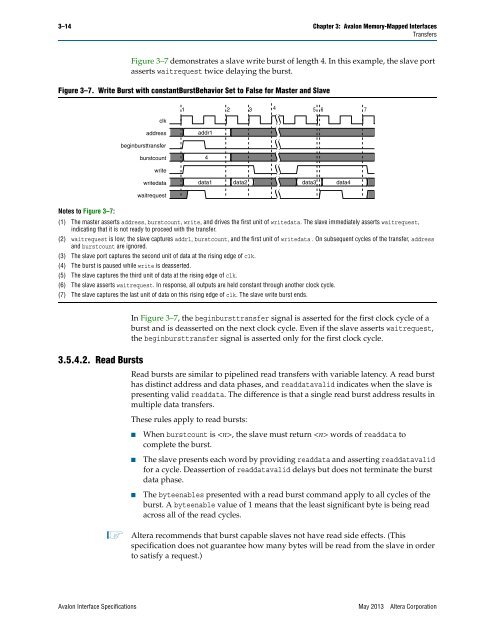Avalon Interface Specifications (PDF) - Altera
Avalon Interface Specifications (PDF) - Altera
Avalon Interface Specifications (PDF) - Altera
You also want an ePaper? Increase the reach of your titles
YUMPU automatically turns print PDFs into web optimized ePapers that Google loves.
3–14 Chapter 3: <strong>Avalon</strong> Memory-Mapped <strong>Interface</strong>s<br />
Transfers<br />
3.5.4.2. Read Bursts<br />
Figure 3–7 demonstrates a slave write burst of length 4. In this example, the slave port<br />
asserts waitrequest twice delaying the burst.<br />
Figure 3–7. Write Burst with constantBurstBehavior Set to False for Master and Slave<br />
Notes to Figure 3–7:<br />
clk<br />
address<br />
beginbursttransfer<br />
burstcount<br />
write<br />
writedata<br />
waitrequest<br />
1 2 3 4 5 6<br />
7<br />
addr1<br />
(1) The master asserts address, burstcount, write, and drives the first unit of writedata. The slave immediately asserts waitrequest,<br />
indicating that it is not ready to proceed with the transfer.<br />
(2) waitrequest is low; the slave captures addr1, burstcount, and the first unit of writedata . On subsequent cycles of the transfer, address<br />
and burstcount are ignored.<br />
(3) The slave port captures the second unit of data at the rising edge of clk.<br />
(4) The burst is paused while write is deasserted.<br />
(5) The slave captures the third unit of data at the rising edge of clk.<br />
(6) The slave asserts waitrequest. In response, all outputs are held constant through another clock cycle.<br />
(7) The slave captures the last unit of data on this rising edge of clk. The slave write burst ends.<br />
In Figure 3–7, the beginbursttransfer signal is asserted for the first clock cycle of a<br />
burst and is deasserted on the next clock cycle. Even if the slave asserts waitrequest,<br />
the beginbursttransfer signal is asserted only for the first clock cycle.<br />
Read bursts are similar to pipelined read transfers with variable latency. A read burst<br />
has distinct address and data phases, and readdatavalid indicates when the slave is<br />
presenting valid readdata. The difference is that a single read burst address results in<br />
multiple data transfers.<br />
These rules apply to read bursts:<br />
4<br />
data1 data2 data3 data4<br />
■ When burstcount is , the slave must return words of readdata to<br />
complete the burst.<br />
■ The slave presents each word by providing readdata and asserting readdatavalid<br />
for a cycle. Deassertion of readdatavalid delays but does not terminate the burst<br />
data phase.<br />
■ The byteenables presented with a read burst command apply to all cycles of the<br />
burst. A byteenable value of 1 means that the least significant byte is being read<br />
across all of the read cycles.<br />
1 <strong>Altera</strong> recommends that burst capable slaves not have read side effects. (This<br />
specification does not guarantee how many bytes will be read from the slave in order<br />
to satisfy a request.)<br />
<strong>Avalon</strong> <strong>Interface</strong> <strong>Specifications</strong> May 2013 <strong>Altera</strong> Corporation
















